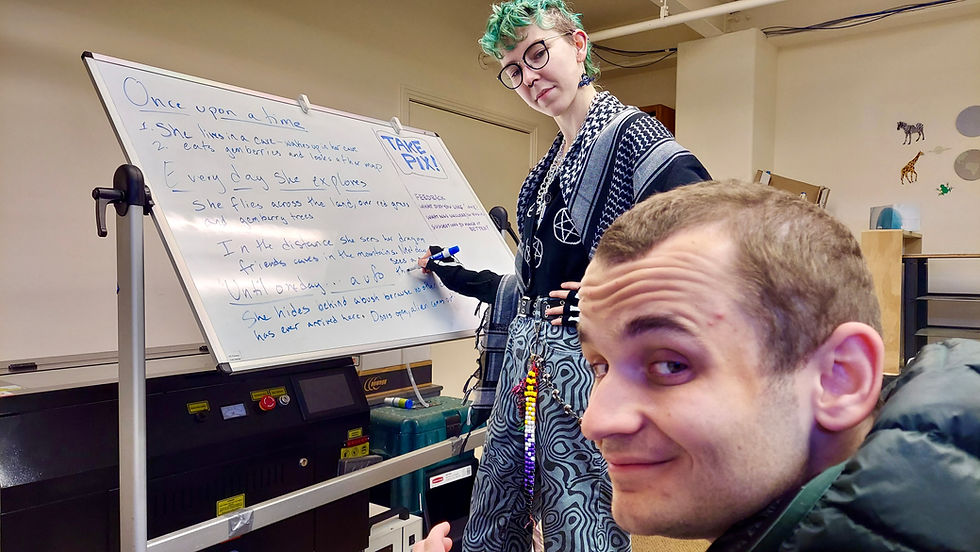Teaching by Example with Ken Pontac - Pro Tips from an Old Pro
- Ken Pontac
- May 20, 2024
- 4 min read
Updated: May 21, 2024
Ken Pontac is an Emmy-nominated writer, producer, and director of animation and videogames. Pontac currently works with autistic/neurodivergent teens and adults at Autistry Studios, helping them create animated shorts through the Story Xperiential program.
After a lifetime in the business, I’m familiar with the techniques taught in Story Xperiential. Mentoring the class has simplified and clarified the way that I teach these fundamentals. The precise and elegant manner in which the course is laid out is a perfect framework that allows me to elaborate with anecdotes and examples from my personal experience. I feel like this program is a perfect partner, and, to quote Rick from Casablanca, “I think this is the beginning of a beautiful friendship".
I’ve been mentoring at Autistry Studios, using the Story Xperiential program, for several semesters, and this time I decided to join the students in participating with my own project to give them a real-time perspective on how it’s done in the industry. I wanted to use the least labor-intensive technique I could think of, so I decided on stop-motion. Having worked in that medium for years on shows like Gumby, Gary & Mike, and my own series Bump in the Night, I knew every trick to expedite production with minimum effort (at least that’s what I thought!).
Ken showing Brendan how to simulate skydiving by manipulating cutout clouds on the multiplane stage.
It was important to show the students how conflict comes from character, and how opposites attract (generally after some initial friction). I’d decided to animate the items available on my desk, so I asked, “What if a stapler fell in love with a staple remover?” The pitch got giggles from the students as we started to spitball the characters.

It was a wonderful session with an engaged and interested class. Sebastian Stapleton, the stapler in my story, turned out to be the son of rich parents who lived in the tidy side of the desk. Unlike his conservative parents, Sebastian wanted to use his privilege to help the less fortunate on the messy side. A good number of Autistry students are deeply conscious of social issues, and had a lot to say about Sebastian’s backstory and motivations. Sebastian came from a strong, bonded family, while the staple remover, Penelope Pullapart, was a discard from a yard sale with no family and serious trust issues. Many of these traits resonated in the room, opening up deeper and more personal conversations. This intimate glimpse inside the minds of the students is one of the most valuable aspects of the Story Xperiential program. The stories they tell in this class are ones they might not reveal elsewhere. They often name the protagonists after themselves, and the victories they achieve mirror their own aspirations.

Mentor Benji Harrington transcribes Nat’s story Penelope the Dragon and the Alien Invasion onto the white board.
The character design phase of my What If was simple. I just had to determine what sort of office supplies I could purchase from Jeff Bezos (most of them, it turns out). The students were amused that I was taking pictures of things found around the house to facilitate my drawings. I’m constantly advocating the value of photo reference, and occasionally take pictures of the students in specific poses for their storyboards. One of the students, Brendan, has embraced this concept, and his drawing skills have skyrocketed since the class began.
The story spine session with the students was straightforward, since we’d gone over a lot of the plot in previous sessions. There were a few wild diversions from the path I’d planned (this is Autistry, after all), but every idea was met with respect and consideration. This phase of the story process teaches critical social skills: teamwork, waiting one’s turn to speak, framing ideas as suggestions instead of demands, giving feedback as a positive and never a negative, and perhaps most important, listening. Listening is a vital skill for anybody, but many of our students have trouble remaining focused. The excitement of the writers’ room is contagious, and compels concentration and participation. Every student gets a turn at the whiteboard, and every student is welcome to make suggestions. The final choice is always the filmmaker’s.
The video of my story spine is here on YouTube:
AND the final stop-motion animation: Stapled Heart:
One of the most difficult lessons to teach in this class has been the use of dramatic angles and cutting to help tell a story. I wanted to illustrate this to the students, so I created as much variation as possible in my boards. Everything I did was a reiteration of the Story Xperiential lessons, and working in real-time allowed me to apply what I was doing to specific issues in the students’ work.


The establishing shot of Desktopolis was a useful example to several students who needed to set their scenes.

Chris’s establishing shot of Vlad’s castle in Loch Ness Monster vs. Vlad the Vampire.

Brendan’s establishing shot of the city in SPEAK!
This semester’s final films have been remarkable. I’m proud of the students for the hard work they’ve done and delighted by the results. Every one of their stories has heart, humor, and a happy ending.
Autistry Studios and Ken Pontac were featured in the Pacific Sun, read all about it: https://pacificsun.com/autistry-studios-creates-community-for-autistic-adults/

During his 40 years in the field, he's worked on many classics: Gumby, Woody Woodpecker, Marvel Heroes, Arthur, Frog & Toad, Curious George, Sonic the Hedgehog, Pac-Man, Octonauts, Happy Tree Friends, and LazyTown. Pontac lives in Sausalito with a beautiful redheaded nurse, a tranquil Xoloitzcuintli named Chalupa, and a not-so-tranquil Xoloitzcuintli puppy named Ziggy Stardust.




